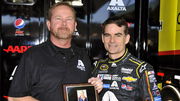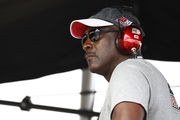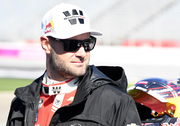
via Imago
Jimmie Johnson

via Imago
Jimmie Johnson
Folks, if anyone knows NASCAR inside out, it has to be Jimmie Johnson. The seven-time Cup Series champion is now a majority stake-holding team owner of Legacy Motor Club. During his driving days, he piloted for Hendrick Motorsports, which also happens to be the winningest team of the sport. That, plus his race-winning talent, made him one of the highest-paid drivers of his time. That feat now belongs to Kyle Busch, who earns around $16.9 million yearly salary. The reason behind talking money is Johnson claiming that the driver salaries have hit an all-time low. And, this is surprising, considering the developments in the sport.
NASCAR has bagged a record high $7.7 billion media rights deal. This means the race purses have to be bigger. And as per NASCAR, the new charter agreement offers teams a higher cut than before. So this comment from JJ is a bit confusing. Could it be big-name sponsors leaving the sport? But at the same time, with private equity investors coming in, the inflow of cash is still high. So, what revelation is this veteran driver-now-owner trying to make?
ADVERTISEMENT
Article continues below this ad
Why are NASCAR driver salaries taking a toll?
NASCAR CEO Steve Phelps has been boasting about NASCAR’s growth. Recently, he said, “Six years ago, private equity firms weren’t as focused on NASCAR as they are today. I’ve had numerous conversations with these firms, and they are keen to invest in race teams. They want to understand the sport’s future, and they are buying into what we are selling.” This is the clearest picture of the sport’s popularity. The likes of attracting Legendary racers from other motorsports like Shane van Gisbergen, Katherine Legge, and Kimi Räikkönen shows us a wave of popularity towards NASCAR!
Jimmie Johnson’s own team recently rode this wave when it partnered with Knighthood Capital Management. So, money in the sport is evident. It’s puzzling why JJ, on the recent episode of the podcast Business of Sport, said, “Less. For sure,” when asked, “Do drivers get paid more now or less?”
Jimmie Johnson‘s reasoning for this is a reduced amount of workload. He compared it to the amount of workload he had back in the day versus the active drivers. “Yeah, it’s reflective of contract cycles. Also the workload is a bit less. There are many cost savings put in the plan. Another one is the OEMs control the technology. So, NASCAR will allow each OEM to have three test sessions during the course of the year. The OEMs also control the wind tunnel time. The OEMs also control the tire tests and development time that’s allotted. All that in the past, any team could do that on their own and at will.” It’s interesting how the dynamics of test runs have changed with the next-gen cars.
Running just three test sessions isn’t much. When Johnson was piloting the #48, they tested all year round. “So, during my generation of driving. You know, I drove for Hendrick Motorsports. My car, the #48 car, we had our own test team. So we would be gone at a race track Thursday to Sunday racing. Monday night for our test session, I was on track with our test team for Tuesday, Wednesday. Leave Thursday night for the next race. I had 22 test sessions in between my 38 weekends of racing, so again, all these expenses. Now, all these are gone. The OEMs control all the testing. We are given data, and then we go to our simulators, where our engineers try to take that data and apply it.”
And well, it’s not just more work equals more money. According to the LMC owner, back in the day, there was a lot more capital, and teams would spend money like anything. It could be because the sport was at the peak of its popularity back then. “Back in the year that I drove, money was plentiful. Every driver had their own private plane. Every team had their private fleet of aircraft. The contracts have shrunk. So now there are some legitimate charter services which are quite affordable. And teams aren’t required to own their own aircrafts and have their own hanger and their own flight crew. It’s really helped the bottom line. Because there’s no way we can travel,” Jimmie Johnson said.
So basically, we are square one to their being less capital in the sport. Or at least with the teams. And we are not talking about the big dogs here, but the smaller, backmarker teams. And to bring more parity. NASCAR is planning to bring in a hard spending cap in 2027. “There is a hard cap coming into play in 2027. And it’s still being negotiated. But I would assume anything that promotes the sport would be excluded. So our racing facilities are like museums. So our facility would be out of that. Driver contracts would be out of it. But travel, your technology spend (might be included),” Johnson added.
What’s your perspective on:
Are cost caps in NASCAR leveling the playing field or stifling the sport's growth?
Have an interesting take?
Do you feel these things are choking the sport? If yes, then this must also be inferred that it’s also what allowed Jimmie Johnson to come into the sport as an owner and thrive. And not just LMC, all other young teams like JR Motorsports and Tricon Garage. And, this parity is changing an age-old conception about the sport.
ADVERTISEMENT
Article continues below this ad
Trending
Parity is needed for NASCAR to survive
Today in NASCAR, we have three big names: Hendrick Motorsports, Joe Gibbs Racing, and Team Penske. But thanks to the next-gen car bringing parity in teams, we see 23XI Racing flourishing, or someone like Trackhouse Racing running on top on some weekends. Or how Josh Berry, in the #21 of Wood Brothers Racing, managed to pull a win. Had there been no parity or cost caps, the top 3 or basically the ones with the maximum money would have been thriving.
And then Jimmie Johnson, Justin Marks, and Denny Hamlin would have never even thought of becoming owners in the sport. This is why someone like Red Bull, McLaren, or Ferrari is so dominant in Formula One with their crazy budgets, while smaller teams like Haas or Alpine struggle. JJ said, “That all ended with the advent of this spec car, and so now we have a spec car which is kind of like a soft spending cap. Which is why I felt comfortable getting into the sport. I don’t have deep pockets like Mr. Hendrick or Mr. Penske does, and I had to come into an environment that was going to be much more safe.”
ADVERTISEMENT
Article continues below this ad
Johnson even credits his seven championships to HMS having the most money. “That was the generation of drivers that I succeeded in. I drove for the guy that had the deepest wallets or deepest pockets and had the greatest success with an unlimited budget, so I was able to win my seven.” So, to have the underdogs thrive and make the sport more interesting. We need that parity.
What are your thoughts on this? Share with us in the comments below.
ADVERTISEMENT
ADVERTISEMENT
ADVERTISEMENT
ADVERTISEMENT







Are cost caps in NASCAR leveling the playing field or stifling the sport's growth?